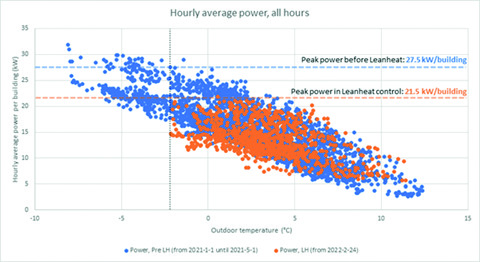Solution provider

The global climate crisis caused by carbon emissions is a key threat to society and our planet. Danfoss’ energy-efficient and climate-friendly solutions enable a cost-effective green transition.
Case
District heating
District energy


The global climate crisis caused by carbon emissions is a key threat to society and our planet. Danfoss’ energy-efficient and climate-friendly solutions enable a cost-effective green transition.
Add the case to your visit request and let us know that you are interested in visiting Denmark
Together with HOFOR and Københavns Ejendomme og Indkøb (KEID), Danfoss is exploring the potential for optimising the CO2-neutral baseload production in Copenhagen by utilising AI-based heat control from its Leonheat AI system.
The first part of the demonstration took place in the 2021- 2022 heating season and covered 29 municipal buildings (primarily day-care centres and schools). The primary objective of the demonstration is to reduce the peak heat consumption in the mornings (from 6 am to 10 am) by making consumption more flexible. Therefore, the project has been called District Heating Flexumers.
The Danfoss Leanheat AI learns how the buildings behave and utilises the thermal flexibility of buildings (the ability to store heat in the building stock over a period) to reduce peak loads. During the morning peak period, the Leanheat AI diverts the heat stored in the buildings by reducing the heat input by up to 20 percent, whereupon it is recharged before the next morning.
The initial results of the project show that the average morning peak load fell by 14 percent at building level, and at the end of the second part of the demonstration in the upcoming heating season, it is expected to be able to determine what this means at system level. The connected buildings also slightly reduced their heat energy consumption because of compensation from solar
energy forecast by the Leanheat AI. Based on the overall results of the demonstration, it will be possible to quantify the overall financial and environmental benefits.
Looking at the total heating consumption on an hourly basis as an average per building, the peak output fell from 27.5 kW/ building to 21.5 kW/building (-22 percent). The calculation was made by comparing the highest peak during peak load displacement with the highest measured peak last year under the same outdoor conditions. Any obvious outliers were ignored in the analysis.
“As a district heating company, HOFOR considers district heating flexumers as an important step towards reducing peak-load production and creating access to more renewable-based heat generations” – Kristian Honoré, Energy Planner, HOFOR
